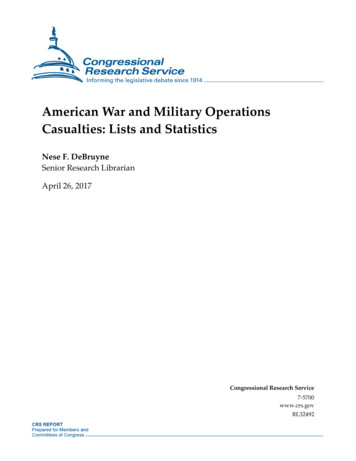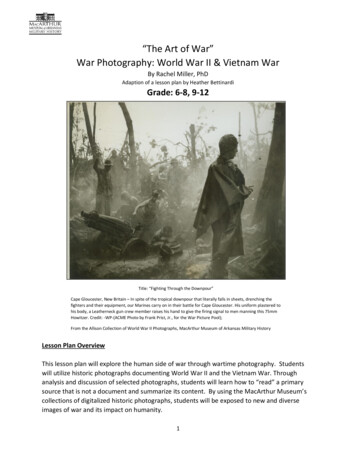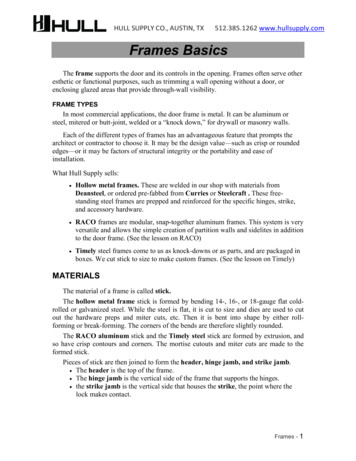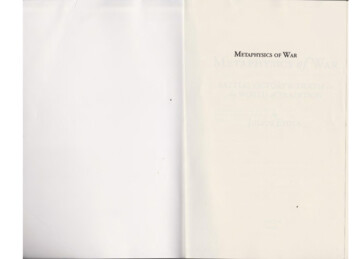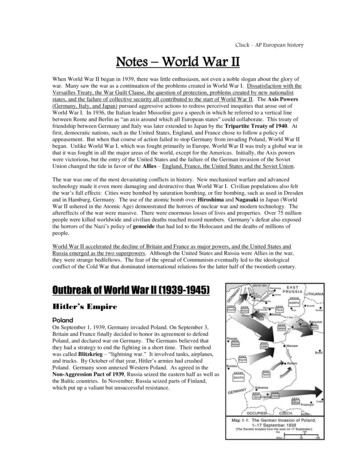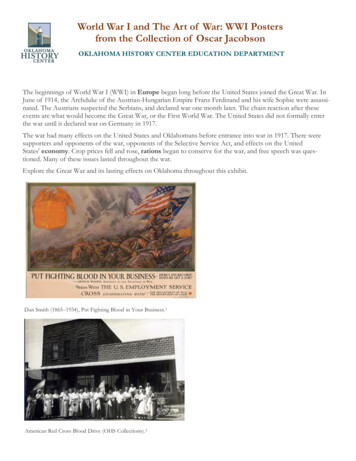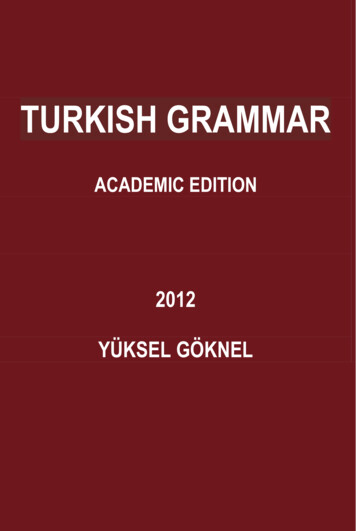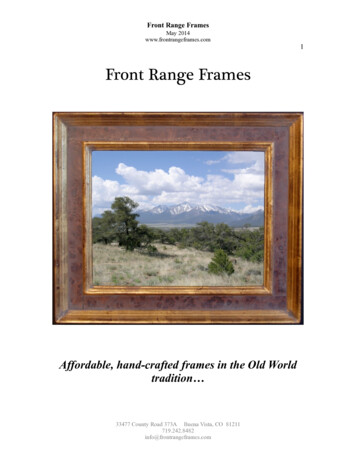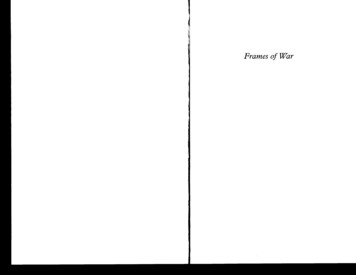
Transcription
Frames of War
Frames of WarWhen Is Life Grievable?JUDITH BUTLERi'f; /VERSOLondon New York.)1i
ContentsFirst published by Verso 2009 Judith Butler 2009All rights reservedThe moral rights of the author have been asserted1 3 5 7 9 10 8 6 4 2VersoUK: 6 Meard Street, London W1F OEGUS: 20 Jay Street, Suite 1010, Brooklyn, NY 11201www.versobooks.comVerso is the imprint of New Left BooksISBN-13: 978-1-84467-333-9British Library Cataloguing in Publication DataA catalogue record for this book is available from the British LibraryLibrary of Congress Cataloging-in-Publication DataA catalog record for this book is available from the Library of CongressTypeset by Hewer Text UK Ltd, EdinburghPrinted in the US by Maple VailAcknowledgmentsIntroduction: Precarious LifeJ Grievable Life1 Survivability, Vulnerability, Affect2 Torture and the Ethics of Photography:Thinking with Sontag3 Sexual Politics, Torture, and Secular Time4 Non-Thinking in the Name of the Normative5 The Claim of Non-ViolenceIndexvii13363101137165185
AcknowledgmentsThese essays were written and revised between 2004and 2008. Although some of them have appeared inearlier forms, they have been substantially revised forthe purposes of this book. An earlier version of Chapter1, "Survivability, Vulnerability, Affect," was publishedby the Centre de Cultura Contempodmia de Barcelonain English and Catalan in 2008. "Torture and theEthics of Photography" appeared in an earlier version inSociety and Space, the journal of the Royal GeographicalSociety, and in Bilderpolitik in Zeiten von Krieg undTerror: Medien, Macht und Geschlechterverhaltnisse, ed.Linda Hentschel, Berlin: b books, 2008. Chapter 2also draws on my essay "Photography, War, Outrage,"published in the PMLA in December 2005. "SexualPolitics, Torture, and Secular Time" appeared first inthe British Journal of Sociology (59: 1) in March 2008."Non-Thinking in the Name of the Normative" drawsupon a reply I wrote to several responses to "SexualPolitics" in the British Journal of Sociology (59: 2). "TheClaim of Non-Violence" draws upon "Violence andNon-Violence of Norms: Reply to Mills and Jenkins,"in differences (18: 2) in fall 2007. The argument of thetext was elaborated in a series of seminars I gave in
viiiACKNOWLEDGMENTSParis for the Ecole Normale Superieure and the Ecoledes hautes etudes in the spring of 2008.I am grateful for discussions I have had with severalinterlocutors over these last years which informed andchanged my thinking: Frances Bartkowski, Etienne Balibar,Jay Bernstein, Wendy Brown, Yoon Sook Cha, AlexandraChasin, Tom Dumm, Samera Esmeir, Michel Feher, EricFassin, Faye Ginsburg, Jody Greene, Amy Huber, NaciraGuenif-Souilamas, Shannon Jackson, Fiona Jenkins, LindaHentschel, Saba Mahmood, Paola Marrati, Mandy Merck,Catherine Mills, Ramona Naddaff, Denise Riley, LeticiaSabsay, Gayle Salamon, Kim Sang Ong-Van-Cung, JoanW. Scott, Kaja Silverman, and Linda Williams. I am gratefulfor the Humanities Research Fellowship at the Universityof California at Berkeley and Dean Janet Broughton whoprovided me with the support required to finish this text.I thank Colleen Pearl and Jill Stauffer for their editorialwork on the manuscript (though all errors are emphaticallymine). I thank Tom Penn at Verso for encouraging andediting the project. The text is dedicated to my studentswho have moved and changed my thinking.This manuscript was completed a month after the electionof Barack Obama to the US presidency, and we have yetto see what concrete ameliorations of war may take placeunder his administration. In a way, the occasions for theseessays emerged from the wars instigated by the Bushadministration, but I am clear that the reflections containedherein are not limited to the vagaries of that regime. Thecritique of war emerges from the occasions of war, but itsaim is to rethink the complex and fragile character of thesocial bond and to consider what conditions might makeviolence less possible, lives more equally grievable, and,hence, more livable.INTRODUCTIONPrecarious Life, Grievable LifeThis book consists of five essays written in response tocontemporary war, focusing on cultural modes of regulatingaffective and ethical dispositions through a selective anddifferential framing of violence. In some ways the book followson from Precarious Life, published by Verso in 2004, especiallyits suggestion that specific lives cannot be apprehended asinjured or lost if they are not first apprehended as living. Ifcertain lives do not qualify as lives or are, from the start, notconceivable as lives within certain epistemological frames,then these lives are never lived nor lost in the full sense.On the one hand, I am seeking to draw attention to theepistemological problem raised by this issue of framing:the frames through which we apprehend or, indeed, fail toapprehend the lives of others as lost or injured (lose-ableor injurable) are politically saturated. They are themselvesoperations of power. They do not unilaterally decide theconditions of appearance but their aim is nevertheless todelimit the sphere of appearance itself. On the other hand, theproblem is ontological, since the question at issue is: What isa life? The "being" oflife is itself constituted through selectivemeans; as a result, we cannot refer to this "being" outside ofthe operations of power, and we must make more precise thespecific mechanisms of power through which life is produced.
2FRAMES OF WARPRECARIOUS LIFE, GRIEVABLE LIFEObviously, this insight has consequences for thinking about"life" in cellular biology and the neurosciences, since certainways of framing life inform those scientific practices as wellas debates about the beginning and end of life in discussionsof reproductive freedom and euthanasia. Although what Ihave to say may have some implications for those debates,my focus here will be on war---on why and how it becomeseasier, or more difficult, to wage.precariousness for some and minimize precariousness forothers. It is not possible first to define the ontology of thebody and then to refer to the social significations the bodyassumes. Rather, to be a body is to be exposed to socialcrafting and form, and that is what makes the ontology of thebody a social ontology. In other words, the body is exposed tosocially and politically articulated forces as well as to claims ofsociality-including language, work, and desire-that makepossible the body's persisting and flourishing. The more orless existential conception of "precariousness" is thus linkedwith a more specifically political notion of "precarity." Andit is the differential allocation of precarity that, in my view,forms the point of departure for both a rethinking of bodilyontology and for progressive or left politics in ways thatcontinue to exceed and traverse the categories of identity. 1The epistemological capacity to apprehend a life is partiallydependent on that life being produced according to normsthat qualify it as a life or, indeed, as part of life. In this way,the normative production of ontology thus produces theepistemological problem of apprehending a life, and this in turngives rise to the ethical problem of what it is to acknowledgeor, indeed, to guard against injury and violence. Of course,we are talking about different modalities of "violence" at eachlevel of this analysis, but that does not mean that they are allequivalent or that no distinctions between them need to bemade. The "frames" that work to differentiate the lives wecan apprehend from those we cannot (or that produce livesacross a continuum oflife) not only organize visual experiencebut also generate specific ontologies of the subject. Subjectsare constituted through norms which, in their reiteration,produce and shift the terms through which subjects areTo Apprehend a LifeThe precarity of life imposes an obligation upon us. Wehave to ask about the conditions under which it becomespossible to apprehend a life or set of lives as precarious, andthose that make it less possible, or indeed impossible. Ofcourse, it does not follow that if one apprehends a life asprecarious one will resolve to protect that life or secure theconditions for its persistence and flourishing. It could be, asboth Hegel and Klein point out in their different ways, thatthe apprehension of precariousness leads to a heighteningof violence, an insight into the physical vulnerability ofsome set of others that incites the desire to destroy them.And yet, I want to argue that if we are to make broadersocial and political claims about rights of protection andentitlements to persistence and flourishing, we will first haveto be supported by a new bodily ontology, one that impliesthe rethinking of precariousness, vulnerability, injurability,interdependency, exposure, bodily persistence, desire, workand the claims of language and social belonging.To refer to "ontology" in this regard is not to lay claimto a description of fundamental structures of being that aredistinct from any and all social and political organization.On the contrary, none of these terms exist outside of theirpolitical organization and interpretation. The "being" of thebody to which this ontology refers is one that is always givenover to others, to norms, to social and political organizationsthat have developed historically in order to maximize3IFor related views, see Robert Castel, Les metamorphoses de la questionsociale, une chronique du salariat, Paris: Editions Gallimard, 1999, translatedby Richard Boyd as From Manual Workers to Wage Labourers: Transformation ofthe Social Question, Edison, NJ: Transaction Publishers, 2005. See also SergePaugam, Le salarie de la precarite, Paris: PDF, 2000; Nancy Ettlinger, "PrecarityUnbound," Alternatives 32 (2007),319-40.
FRAMES OF WARPRECARIOUS LIFE, GRIEVABLE LIFErecognized. These normative conditions for the production ofthe subject produce an historically contingent ontology, suchthat our very capacity to discern and name the "being" of thesubject is dependent on norms that facilitate that recognition.At the same time, it would be a mistake to understand theoperation of norms as deterministic. Normative schemes areinterrupted by one another, they emerge and fade dependingon broader operations of power, and very often come upagainst spectral versions of what it is they claim to know:thus, there are "subjects" who are not quite recognizable assubjects, and there are "lives" that are not quite--or, indeed,are never-recognized as lives. In what sense does life, then,always exceed the normative conditions of its recognizability?To claim that it does so is not to say that "life" has as itsessence a resistance to normativity, but only that each andevery construction of life requires time to do its job, and thatno job it does can overcome time itself. In other words, thejob is never done "once and for all." This is a limit internal tonormative construction itself, a function of its iterability andheterogeneity, without which it cannot exercise its craftingpower, and which limits the finality of any of its effects.Perhaps, then, as a consequence, it is necessary to considerhow we might distinguish between "apprehending" and"recognizing" a life. "Recognition" is the stronger term,one that has been derived from Hegelian texts and subjectto revisions and criticisms for many years. 2 "Apprehension"is less precise, since it can imply marking, registering,acknowledging without full cognition. If it is a form ofknowing, it is bound up with sensing and perceiving, butin ways that are not always--or not yet--conceptual formsof knowledge. What we are able to apprehend is surelyfacilitated by norms of recognition, but it would be a mistaketo say that we are utterly limited by existing norms ofrecognition when we apprehend a life. We can apprehend,for instance, that something is not recognized by recognition.Indeed, that apprehension can become the basis for a critiqueof norms of recognition. The fact is we do not simply haverecourse to single and discrete norms of recognition, butto more general conditions, historically articulated andenforced, of "recognizability." If we ask how recognizabilityis constituted, we have through the very question taken upa perspective suggesting that these fields are variably andhistorically constituted, no matter how a priori their functionas conditions of appearance. If recognition characterizesan act or a practice or even a scene between subjects, then"recognizability" characterizes the more general conditionsthat prepare or shape a subject for recognition-the generalterms, conventions, and norms "act" in their own way,crafting a living being into a recognizable subject, thoughnot without errancy or, indeed, unanticipated results. Thesecategories, conventions, and norms that prepare or establisha subject for recognition, that induce a subject of this kind,precede and make possible the act of recognition itself. In thissense, recognizability precedes recognition.42 See, for example, Jessica Benjamin, Like Subjects, Love Objects: Essays onRecognition and Sexual Difference, New Haven: Yale University Press, 1995;Nancy Fraser, Justice Interruptus: Critical Reflections on the "Postsocialist"Condition, New York: Routledge, 1997; Fraser and Axel Honneth, Redistributionor Recognition? A Political-Philosophical Exchange, London: Verso, 2003; AxelHonneth, The Struggle for Recognition: The Moral Grammar of Social Conflicts,Cambridge: Polity Press, 1996; Reijication: A New Look At An Old Idea (TheBerkeley Tanner Lectures), New York: Oxford University Press, 2008; PatchenMarkell, Bound By Recognition, Princeton: Princeton University Press, 2003;Charles Taylor, Hegel and Modern Society, Cambridge: Cambridge UniversityPress, 1979; and Taylor and Amy Gutman, eds, Multiculturalism: Examining thePolitics of Recognition, Princeton: Princeton University Press, 1994.5Frames of RecognitionHow then is recognizability to be understood? In thefirst instance, it is not a quality or potential of individualhumans. This may seem absurd asserted in this way,but it is important to question the idea of personhood asindividualism. If we claim that recognizability is a universalpotential and that it belongs to all persons as persons, then,
7FRAMES OF WARPRECARIOUS UFE, GRIEVABLE UFEin a way, the problem before us is already solved. We havedecided that some particular notion of "personhood" willdetermine the scope and meaning of recognizability. Thus,we install a normative ideal as a preexisting condition of ouranalysis; we have, in effect, already "recognized" everythingwe need to know about recognition. There is no challengethat recognition poses to the form of the human that hastraditionally served as the norm of recognizability, sincepersonhood is that very norm. The point, however, will be toask how such norms operate to produce certain subjects as"recognizable" persons and to make others decidedly moredifficult to recognize. The problem is not merely how toinclude more people within existing norms, but to considerhow existing norms allocate recognition differentially. Whatnew norms are possible, and how are they wrought? Whatmight be done to produce a more egalitarian set of conditionsfor recognizability? What might be done, in other words, toshift the very terms of recognizability in order to producemore radically democratic results?If recognition is an act or practice undertaken by atleast two subjects, and which, as the Hegelian framewould suggest, constitutes a reciprocal action, thenrecognizability describes those general conditions on thebasis of which recognition can and does take place. It seems,then, that there are still two further terms to understand:apprehension, understood as a mode of knowing that is notyet recognition, or may remain irreducible to recognition;and intelligibility, understood as the general historicalschema or schemas that establish domains of the knowable.This would constitute a dynamic field understood, at leastinitially, as an historical a priori. 3 Not all acts of knowingare acts of recognition, although the inverse claim wouldnot hold: a life has to be intelligible as a life, has to conformto certain conceptions of what life is, in order to becomerecognizable. So just as norms of recognizability preparethe way for recognition, so schemas of intelligibilitycondition and produce norms of recognizability.Those norms draw upon shifting schemes ofintelligibility,so that we can and do have, for example, histories of lifeand histories of death. Indeed, we have ongoing debatesabout whether the fetus should count as life, or a life, or ahuman life; we have further debates about conception andwhat constitutes the first moments of a living organism; wehave debates also about what constitutes death, whether itis the death of the brain, or of the heart, whether it is theeffect of a legal declaration or a set of medical and legalcertificates. All of these debates involve contested notionsof personhood and, implicitly, questions regarding the"human animal" and how that conjunctive (and chiasmic)existence is to be understood. The fact that these debatesexist, and continue to exist, does not imply that life anddeath are direct consequences of discourse (an absurdconclusion, if taken literally). Rather, it implies that thereis no life and no death without a relation to some frame.Even when life and death take place between, outside,or across the frames by which they are for the most partorganized, they still take place, though in ways that call intoquestion the necessity of the mechanisms through whichontological fields are constituted. If a life is producedaccording to the norms by which life is recognized, thisimplies neither that everything about a life is producedaccording to such norms nor that we must reject theidea that there is a remainder of "life"-suspended andspectral-that limns and haunts every normative instanceof life. Production is partial and is, indeed, perpetuallyhaunted by its ontologically uncertain double. Indeed,every normative instance is shadowed by its own failure,and very often that failure assumes a figural form. Thefigure lays claim to no certain ontological status, and63For the "historical a priori," see Michel Foucault, The Archaeology ofKnowledge, trans. A.M. Sheridan, London: Tavistock Publications Ltd, 1972.See also Foucault, The Order of Things: An Archaeology of the Human Sciences,New York: Vintage, 1970.
FRAMES OF WARPRECARIOUS LIFE, GRIEVABLE LIFEthough it can be apprehended as "living," it is not alwaysrecognized as a life. In fact, a living figure outside thenorms oflife not only becomes the problem to be managedby normativity, but seems to be that which normativityis bound to reproduce: it is living, but not a life. It fallsoutside the frame furnished by the norm, but only as arelentless double whose ontology cannot be secured, butwhose living status is open to apprehension.As we know, "to be framed" is a complex phrase inEnglish: a picture is framed, but so too is a criminal (bythe police), or an innocent person (by someone nefarious,often the police), so that to be framed is to be set up, or tohave evidence planted against one that ultimately "proves"one's guilt. When a picture is framed, any number of waysof commenting on or extending the picture may be at stake.But the frame tends to function, even in a minimalist form,as an editorial embellishment of the image, if not a selfcommentary on the history of the frame itself. 4 This sensethat the frame implicitly guides the interpretation has someresonance with the idea of the frame as a false accusation.If one is "framed," then a "frame" is constructed aroundone's deed such that one's guilty status becomes theviewer's inevitable conclusion. Some way of organizing andpresenting a deed leads to an interpretive conclusion aboutthe deed itself. But as we know from Trinh Minh-ha, it ispossible to "frame the frame" or, indeed, the "framer,"swhich involves exposing the ruse that produces the effectof individual guilt. To frame the frame seems to involve acertain highly reflexive overlay of the visual field, but, inmy view, this does not have to result in rarified forms ofreflexivity. On the contrary, to call the frame into question isto show that the frame never quite contained the scene it wasmeant to limn, that something was already outside, whichmade the very sense of the inside possible, recognizable.The frame never quite determined precisely what it is wesee, think, recognize, and apprehend. Something exceedsthe frame that troubles our sense of reality; in other words,something occurs that does not conform to our establishedunderstanding of things.A certain leakage or contamination makes this processmore fallible than it might at first appear. Benjamin'sargument about the work of art in the age of mechanicalreproduction can be adapted for the present moment. 6 Thetechnical conditions of reproduction and reproducibilitythemselves produce a critical shifting, ifnot a full deteriorationof context, in relation to the frames deployed by dominantmedia sources during times of war. This means in the firstinstance that even if one could, in considering global mediacoverage, delimit a single "context" for the creation ofwar photography, its circulation would necessarily departfrom such a context. Although the image surely lands innew contexts, it also creates new contexts by virtue of thatlanding, becoming a part of the very process through whichnew contexts are delimited and formed. In other words,the circulation of war photos, as with the disseminationof prison poetry (in the case of the Guantanamo poetsconsidered in Chapter 1) breaks with context all the time:in effect, the poetry leaves the prison, if it does, even whenthe prisoner cannot; the photos circulate on the internet,even when they were not intended for that purpose. The84 This is, of course, more clearly the case with the caption and description,but the frame comments and editorializes in another way. My own reading of theframe here is derived from both critical and sociological sources: see especiallyJacques Derrida, The Truth ofPainting, trans. Geoff Bennington and Ian McLeod,Chicago: Universit)O of Chicago Press, 1987, 37-83. See also Erving Goffman,Frame Analysis: An Essay on the Organization of Experience, New York: Harper& Row, 1974; and Michel Callon, "An Essay on Framing and Overflowing:Economic Externalities Revisited by Sociology," in The Laws of Markets, Boston:Blackwell, 1998, 244-69.5 Trinh T. Minb-ha, Framer Framed, New York: Routledge, 1992.96 Walter Benjamin, "The Work of Art in the Age of Mechanical Reproduction"(1936), in Illuminations: Essays and Reflections, ed. H. Arendt, trans. H. Zohn,New York: Schocken Books, 1969.
FRAMES OF WARPRECARIOUS LIFE, GRIEVABLE LIFEphotos and poetry that fail to circulate-either because theyare destroyed or because they are never permitted to leavethe prison cell-are incendiary as much for what they depictas for the limitations imposed on their circulation (and veryoften for the way those limitations register in the imagesand writing themselves). This very circulability is part ofwhat is destroyed (and if that fact then "leaks" out, thereport on the destructive act circulates in the place of whatis destroyed). What "gets out of hand" is precisely whatbreaks from the context that frames the event, the image, thetext of war. But if contexts are framed (there is no contextwithout an implicit delimitation of context), and if a frameinvariably breaks from itself as it moves through space andtime (if it must break from itself in order to move acrossspace and time), then the circulating frame has to breakwith the context in which it is formed if it is to land or arrivesomewhere else. What would it mean to understand this"breaking out" and "breaking from" as part of the mediaphenomena at issue, as the very function of the frame?The frame that seeks to contain, convey, and determinewhat is seen (and sometimes, for a stretch, succeeds in doingprecisely that) depends upon the conditions of reproducibilityin order to succeed. And yet, this very reproducibility entailsa constant breaking from context, a constant delimitationof new context, which means that the "frame" does notquite contain what it conveys, but breaks apart every timeit seeks to give definitive organization to its content. Inother words, the frame does not hold anything together inone place, but itself becomes a kind of perpetual breakage,subject to a temporal logic by which it moves from placeto place. As the frame constantly breaks from its context,this self-breaking becomes part of the very definition. Thisleads us to a different way of understanding both the frame'sefficacy and its vulnerability to reversal, to subversion, evento critical instrumentalization. What is taken for grantedin one instance becomes thematized critically or evenincredulously in another. This shifting temporal dimensionof the frame constitutes the possibility and trajectory ofits affect as well. Thus the digital image circulates outsidethe confines of Abu Ghraib, or the poetry in Guantanamois recovered by constitutional lawyers who arrange for itspublication throughout the world. The conditions are set forastonishment, outrage, revulsion, admiration, and discovery,depending on how the content is framed by shifting timeand place. The movement of the image or the text outside ofconfinement is a kind of "breaking out," so that even thoughneither the image nor the poetry can free anyone from prison,or stop a bomb or, indeed, reverse the course of the war, theynevertheless do provide the conditions for breaking out ofthe quotidian acceptance of war and for a more generalizedhorror and outrage that will support and impel calls for justiceand an end to violence.Earlier we noted that one sense of "to be framed" meansto be subject to a con, to a tactic by which evidence isorchestrated so to make a false accusation appear true.Some power manipulates the terms of appearance andone cannot break out of the frame; one is framed, whichmeans one is accused, but also judged in advance, withoutvalid evidence and without any obvious means of redress.But if the frame is understood as a certain "breakingout," or "breaking from," then it would seem to be moreanalogous to a prison break. This suggests a certainrelease, a loosening of the mechanism of control, andwith it, a new trajectory of affect. The frame, in this sense,permits-even requires-this breaking out. This happenedwhen the photos of Guantanamo prisoners kneeling andshackled were released to the public and outrage ensued; ithappened again when the digital images from Abu Ghraibwere circulated globally across the internet, facilitating awidespread visceral tum against the war. What happens atsuch moments? And are they merely transient momentsor are they, in fact, occasions when the frame as a forcibleand plausible con is exposed, resulting in a critical andexuberant release from the force of illegitimate authority?1011
12FRAMES OF WARHow do we relate this discussion of frames to theproblem of apprehending life in its precariousness? Itmay seem at first that this is a call for the production ofnew frames and, consequently, for new kinds of content.Do we apprehend the precariousness of life through theframes available to us, and is our task to try to installnew frames that would enhance the possibility of thatrecognition? The production of new frames, as part of thegeneral project of alternative media, is clearly important,but we would miss a critical dimension of this project ifwe restricted ourselves to this view. What happens whena frame breaks with itself is that a taken-for-grantedreality is called into question, exposing the orchestratingdesigns of the authority who sought to control theframe. This suggests that it is not only a question offinding new content, but also of working with receivedrenditions of reality to show how they can and do breakwith themselves. As a consequence, the frames that, ineffect, decide which lives will be recognizable as livesand which will not, must circulate in order to establishtheir hegemony. This circulation brings out or, rather,is the iterable structure of the frame. As frames breakfrom themselves in order to install themselves, otherpossibilities for apprehension emerge. When those framesthat govern the relative and differential recognizability oflives come apart-as part of the very mechanism of theircirculation-it becomes possible to apprehend somethingabout what or who is living but has not been generally"recognized" as a life. What is this specter that gnaws atthe norms of recognition, an intensified figure vacillatingas its inside and its outside? As inside, it must be expelledto purify the norm; as outside, it threatens to undo theboundaries that limn the self. In either case, it figuresthe collapsibility of the norm; in other words, it is a signthat the norm functions precisely by way of managingthe prospect of its undoing, an undoing that inheres inits doings.PRECARIOUS LIFE, GRIEVABLE LIFE13Precariousness and GrievabilityWe read about lives lost and are often given the numbers,but these stories are repeated every day, and the repetitionappears endless, irremediable. And so, we have to ask,what would it take not only to apprehend the precariouscharacter oflives lost in war, but to have that apprehensioncoincide with an ethical and political opposition to thelosses war entails? Among the questions that follow fromthis situation are: How is affect produced by this structureof the frame? And what is the relation of affect to ethicaland political judgment and practice?To say that a life is precarious requires not only that a lifebe apprehended as a life, but also that precariousness be anaspect of what is apprehended in what is living. Normativelyconstrued, I am arguing that there ought to be a moreinclusi
Introduction: Precarious Life J Grievable Life 1 Survivability, Vulnerability, Affect 2 Torture and the Ethics of Photography: Thinking with Sontag 3 Sexual Politics, Torture, and Secular Time 4 Non-Thinking in the Name of the Normative 5 The Claim of Non-Violence Index vii 1 33 63 101 137 165 185 . Acknowledgments These essays were written and revised between 2004 and 2008. Although some of .

